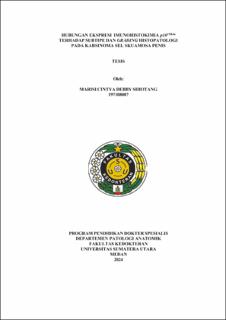Hubungan Ekspresi Imunohistokimia P16INK4a terhadap Subtipe dan Grading Histopatologi pada Karsinoma Sel Skuamosa Penis
The Relationship P16INK4a Immunohistochemistry Expression to Subtype and Histopathological Grading in Penile Squamous Cell Carcinoma

Date
2024Author
Sihotang, Marisi Cintya Debby
Advisor(s)
Intan, T Kemala
Alferraly, T Ibnu
Metadata
Show full item recordAbstract
Background: Penile squamous cell carcinoma is a rare male malignancy in the world. Human Papilloma Virus is the most common risk factor associated with penile squamous cell carcinoma which can be detected by p16INK4a immunohistochemistry. A recent study connect p16INK4a immunohistochemistry with HPV eradication.
Aim: Correlating p16INK4a with subtype and grading of penile squamous cell carcinoma.
Materials and Methods: This research method used a cross sectional study on 30 microscopic preparations of penile squamous cell carcinoma cases from penectomy and biopsy. Microscopic preparations were stained with Hematoxylin and Eosin to define histopathological subtypes, then stained with p16INK4a immunohistochemistry. Material was taken from medical records and the Somers'd test was used to assess the relationship between p16INK4a, subtype and grading of penile squamous cell carcinoma.
Results: From 30 samples, most ages are 40-49 years, most locations are in several regions (mix). The most immunohistochemical expression was weakly positive in the subtype of HPV-associated squamous cell carcinoma of the penis, while in grading the expression was mostly grade 1.
Conclusions: There is a significant relationship between p16INK4a immunohistochemistry and histopathological subtypes with a weak positive picture, but there was no significant relationship with the grading of penile squamous cell carcinoma.
Collections
- Master Theses [128]
